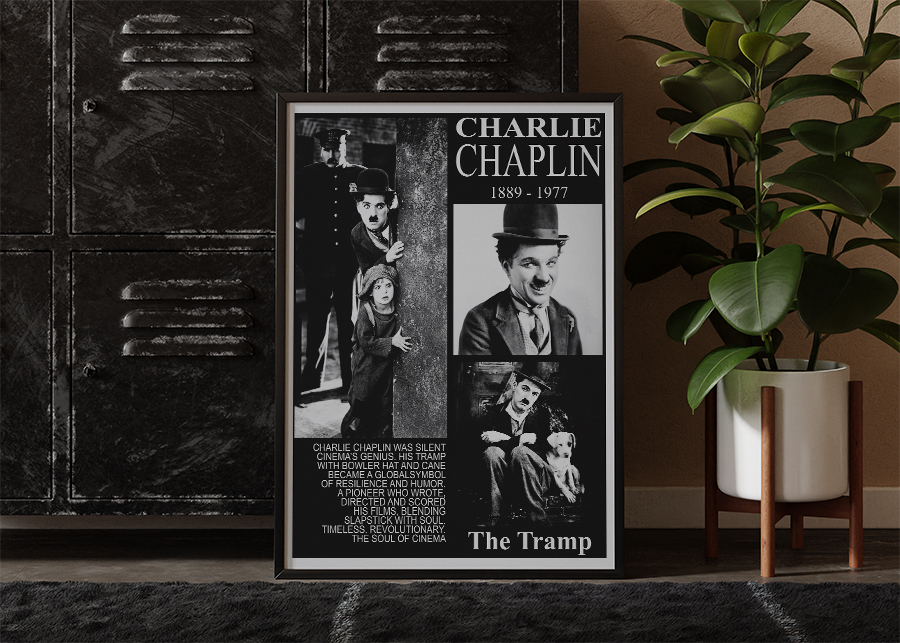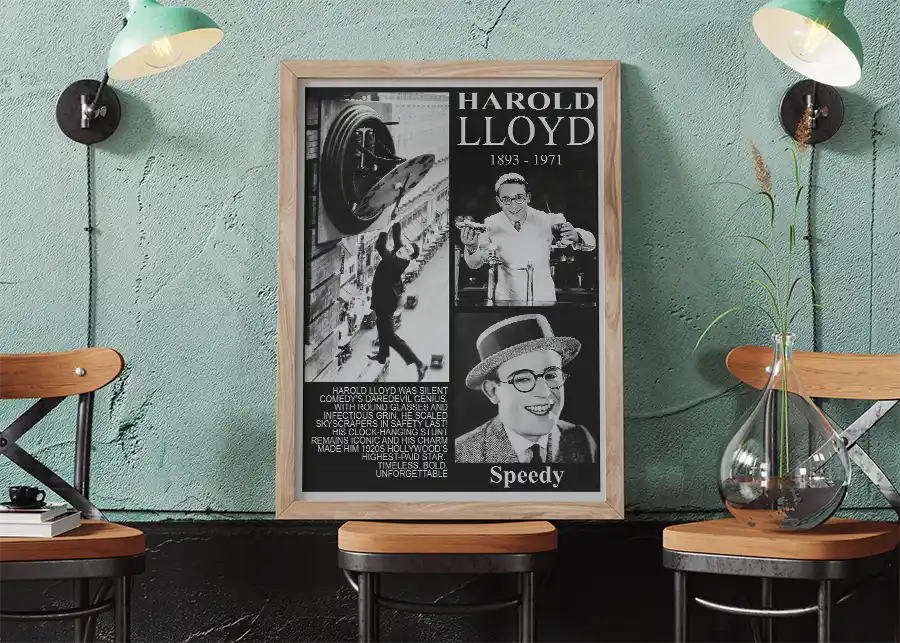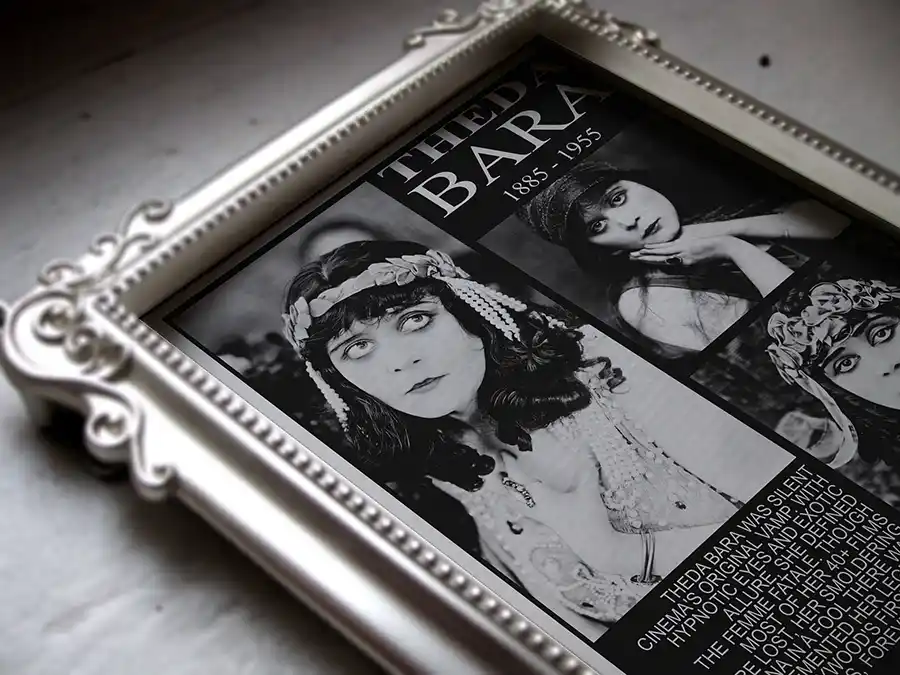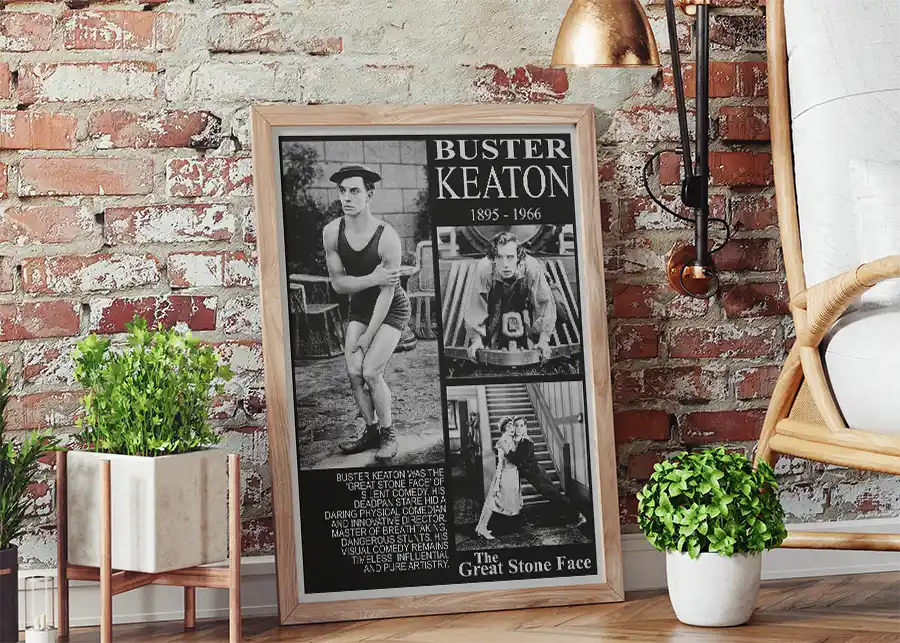Introduction: The Visual Language of Silence
Before Technicolor, before Dolby Atmos, and even before the spoken word, cinema was a universal language of gesture, expression, and breathtaking visual spectacle. The silent film era (c. 1894-1929) was not a primitive precursor to “real” movies; it was a distinct and powerfully evocative art form where directors and actors mastered storytelling through imagery alone. At the heart of this revolution were four iconic figures whose faces and personas became synonymous with the magic of the silver screen: Charlie Chaplin, Harold Lloyd, Theda Bara, and Buster Keaton.
Today, their legacy is not confined to film archives. Contemporary artist Seeress has captured the essence of these legends in a collection of stunning black-and-white printable posters, translating their iconic imagery into modern wall art. This deep dive explores how each star carved their unique path, their surprising interconnections, and how their artistic spirit lives on a century later, both in our cultural memory and on our walls.
Chapter 1: Charlie Chaplin – The Emotional Architect of Comedy
The Birth of the Tramp
Charles Spencer Chaplin’s journey from the impoverished streets of Victorian London to becoming the world’s most recognizable figure is the stuff of legend. His creation, “The Tramp”—with his derby hat, bamboo cane, outsized shoes, and signature waddle—was more than a clown; he was a universal symbol of resilience, hope, and humanity in an increasingly industrial and indifferent world.

The Chaplin Method: Blending Slapstick with Soul
Chaplin’s genius lay in his ability to weave profound social commentary into accessible comedy. In The Kid (1921), he explored poverty and parenthood. In Modern Times (1936), he critiqued industrialization and the dehumanizing assembly line. His films made audiences laugh uproariously one moment and tear up the next, a delicate balance few have ever achieved. His decision to co-found United Artists in 1919 gave him unprecedented creative control, ensuring his vision remained pure and uncompromised.
The Artwork: A Tribute to the Little Fellow
Seeress’s poster, “The Tramp,” distills Chaplin’s complexity into three essential frames: the wistful dreamer, the resilient survivor, and the lovable vagabond. The minimalist, high-contrast design reflects the stark beauty of early film and makes it a versatile piece of art. It’s a perfect centerpiece for a home library, a creative studio, or a living room, serving as a constant reminder of artistry rooted in emotional truth.
Chapter 2: Harold Lloyd – The Darling of the Jazz Age
The Glasses Character
If Chaplin was the sentimental outsider, Harold Lloyd was the optimistic everyman you could imagine as your neighbor. His “Glasses Character”—a bright, ambitious young man eager to prove himself—perfectly encapsulated the energetic spirit of the Roaring Twenties. Lloyd was comedy’s thrill-seeking daredevil, and his image hanging from the clock face in Safety Last! (1923) remains one of the most iconic and anxiety-inducing stunts in film history.
The Business of Laughter
Lloyd was not just a performer but a shrewd businessman. He retained ownership of his films, a move that made him one of the wealthiest stars of his time. His comedy was less about social statements and more about visceral, adrenaline-fueled spectacle and cheerful romance, offering pure, escapist joy to a nation caught between the First World War and the Great Depression.

The Artwork: Capturing “Speedy’s” Energy
The “Speedy” poster by Seeress vibrates with Lloyd’s infectious energy. It captures him in mid-gag: the wide-eyed optimist, the daring stuntman clinging to a ledge, and the charming gentleman. This artwork is ideal for dynamic spaces. Imagine it in a home gym for motivation, a game room for fun, or a 1920s-themed cocktail bar to enhance its nostalgic vibe. It’s a shot of pure, undiluted joy.
Chapter 3: Theda Bara – The Original Silver Screen Siren
The Vamp is Born
Long before femme fatales were a Hollywood staple, Theda Bara defined the archetype. Fox Studios masterminded her exotic persona, claiming she was “Theda Bara” (an anagram for “Arab Death”) and born in the shadow of the Sphinx. In reality, she was Theodosia Burr Goodman from Cincinnati. Her performance in A Fool There Was (1915) with the legendary line “Kiss me, my fool!” catapulted her to fame as the ultimate “vamp,” a woman who used her sexuality and intelligence to manipulate and destroy men.

A Legacy Lost in the Flames
Tragically, Bara’s legacy is a ghostly one. Of her 40+ films, only 3 or 4 survive in complete form; the rest were lost in studio fires or discarded. This makes her a fascinating, almost mythical figure. She represented a bold, dangerous, and complex femininity that was both feared and desired, paving the way for every misunderstood seductress that followed.
The Artwork: Channeling The Vamp
Seeress’s “The Vamp” poster resurrects Bara’s mystique. The artwork focuses on her hypnotic gaze, dramatic flair, and enigmatic aura. This piece is not just decor; it’s a statement. It demands a place of drama: a moody accent wall, a luxurious boudoir, or a dark academia-inspired study. It’s a powerful tribute to a pioneering woman whose work was nearly erased from history.
Chapter 4: Buster Keaton – The Great Stone Face of Surrealism
The Genius of Deadpan
Comedy’s “Big Three” would be incomplete without Buster Keaton. While Chaplin aimed for the heart and Lloyd for the adrenaline, Keaton targeted the funny bone with a unique blend of surrealism, impeccable timing, and mechanical genius. His expression never cracked—earning him the nickname “The Great Stone Face”—no matter how absurd the world collapsed around him. This stoicism made the chaos even funnier and his character’s eventual triumph more satisfying.
The Engineering of Laughter
Keaton was a master filmmaker. His intricate gags, like the entire front of a house falling around him in Steamboat Bill, Jr. (1928) (a stunt performed with millimeter precision), were feats of engineering. He used the film frame as a canvas, with a deep understanding of spatial comedy. His masterpiece, The General (1926), is now rightly hailed as one of the greatest films ever made, a perfect fusion of historical epic, thrilling adventure, and precise comedy.

The Artwork: The Unshakeable Man
The latest addition to the collection, “The Great Stone Face,” immortalizes Keaton’s brilliance. The poster likely features his iconic porkpie hat, his unwavering gaze, and a pose from one of his incredible stunts. This artwork appeals to the intellectual side of comedy—the fan who appreciates the geometry of a perfect gag. It fits perfectly in a modern apartment, a filmmaker’s office, or a gallery wall alongside his peers, completing the narrative of silent comedy’s diverse genius.
Chapter 5: Did the Quartet Know Each Other? A Web of Respect and Rivalry
The paths of these four icons certainly crossed in the small, incestuous world of early Hollywood.
- Chaplin and Lloyd were friendly rivals, often vying for box-office supremacy. They later became neighbors in Beverly Hills.
- Chaplin and Keaton knew each other well and even worked together in the sound era in Limelight (1952). Their comedic styles were often compared, though they greatly respected one another.
- Theda Bara moved in different social circles as a dramatic star under tight studio control, but she would have undoubtedly crossed paths with the comedians at major premieres and industry events.
While they may not have all been close friends, they were a cohort of pioneers, each aware of the others’ work and contributions to the art form they were building together.
Chapter 6: Why This Art Collection Resonates Today
Seeress’s printable poster collection does more than just decorate; it connects us to a foundational chapter of our cultural history.
- Sustainable Art: The print-on-demand model means no wasted inventory or shipping emissions, allowing you to choose your paper and frame sustainably.
- Timeless Aesthetic: The black-and-white, minimalist design is eternally chic, complementing everything from industrial lofts to classic decor.
- A Conversation Starter: These pieces are for those who appreciate history, art, and storytelling. They speak to a sophisticated taste and a desire for decor with meaning.
- Preservation Through Art: For figures like Theda Bara, whose work is largely lost, such artworks act as a vital cultural touchstone, keeping their memory alive for new generations.
Displaying these posters together creates a powerful gallery wall that tells the complete story of silent film—its heart, its thrills, its drama, and its surreal brain.
Conclusion: The Frames Are Forever
Charlie Chaplin, Harold Lloyd, Theda Bara, and Buster Keaton were more than Hollywood movie stars; they were visual poets, athletic innovators, and daring storytellers who defined the very language of cinema. A century later, their influence is everywhere, from the physical comedy of Jackie Chan to the deadpan humor of Wes Anderson films.

Through the art of Seeress, we can bring these legends into our daily lives. These posters are a tribute, a history lesson, and a style statement all in one. They remind us that true artistry is silent, powerful, and timeless.
Ready to bring home a piece of cinema history? Explore the complete collection and find the icon that speaks to you.
